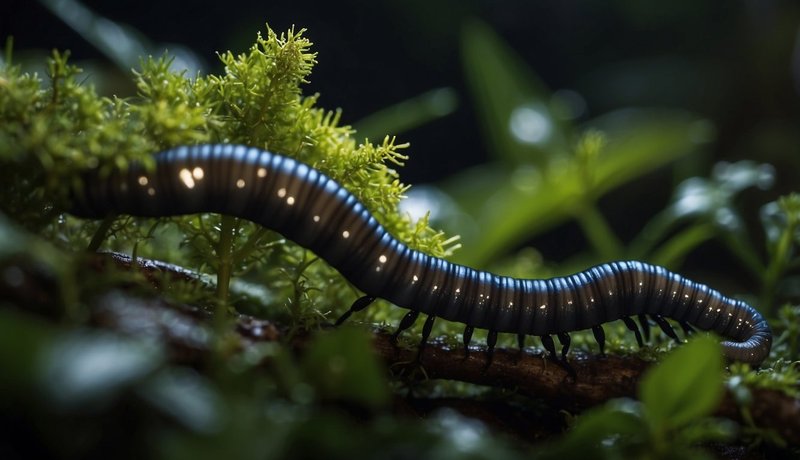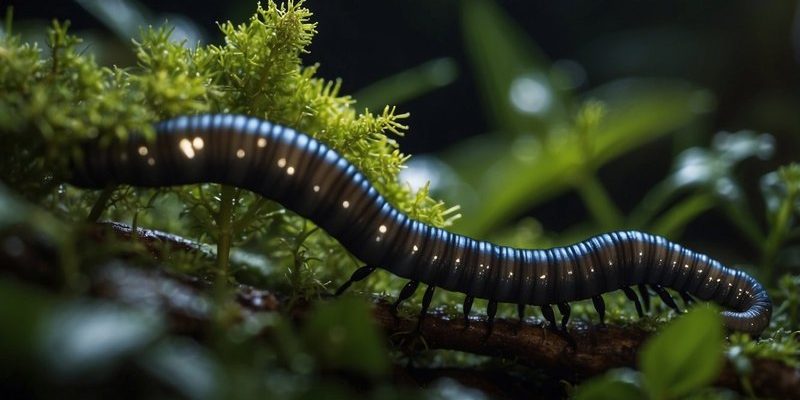
Velvet worms are fascinating because, despite their simple appearance, they have some pretty impressive adaptations for survival. They can sense their environment in ways that many larger animals can’t. So, let’s dive into the world of velvet worms and explore how they pull off this impressive feat of “night vision” in the vast wilderness.
What Are Velvet Worms?
If velvet worms are new to you, it’s time for a quick introduction. These soft-bodied creatures are part of an ancient group of animals that dates back hundreds of millions of years. They’re often found in humid, leaf-littered environments in tropical and subtropical regions.
Here’s the thing: **velvet worms are not worms at all!** They belong to a unique phylum called Onychophora, which means “claw-bearers.” These little critters have distinct features, including a segmented body, stubby legs, and a velvety texture. They also possess a fascinating way of moving; they crawl along surfaces using their legs, somewhat like a caterpillar.
What really sets them apart is the way they hunt. Velvet worms produce a sticky substance from specialized glands, which they shoot at unsuspecting prey to catch them. It’s a bit like shooting a web, similar to how spiders catch their meals but without the spinning!
The Importance of Sensing Prey
Detecting prey in the dark is crucial for velvet worms. They primarily feed on small insects like beetles and other invertebrates, which can be tough to spot when it’s dark. This need to hunt effectively in low-light conditions is where their unique adaptations come into play.
You might be wondering: how do these tiny creatures do it? Well, velvet worms have evolved a set of sensory adaptations that allow them to detect vibrations, chemicals, and even changes in humidity to locate their next meal. This kind of sensory awareness gives them an edge, especially when competing for food in their habitat.
In a way, you could compare their hunting style to that of a blindfolded person at a party trying to find their friend. Instead of relying on sight, they depend on their other senses to pinpoint where the friend might be. For velvet worms, it’s all about using what they have to succeed in finding food.
How Velvet Worms Use Vibrations
One of the key ways velvet worms detect prey is through vibrations. They are incredibly sensitive to the movements around them. When an insect scuttles by, the vibrations travel through the ground and into the bodies of the velvet worms.
Think of it like this: if you’ve ever felt the rumble of a train approaching from a distance, you know how powerful vibrations can be. Similarly, velvet worms can pick up subtle movements even when prey is hidden under leaves or in the dark.
Their **sensitivity to vibrations** gives them a significant advantage. Once they sense movement, they can swiftly maneuver towards the source. This ability to follow vibrations helps them pinpoint their next meal and increases their hunting success rate.
The Role of Chemical Cues
In addition to vibrations, velvet worms also rely on chemical cues in their environment. These creatures are equipped with specialized sensory organs that help them detect pheromones and other chemical signals emitted by potential prey.
Imagine if you were at your favorite restaurant, and you could smell the aroma of a delicious dish being prepared. That’s similar to how velvet worms use their sense of smell to locate food. They can pick up on chemicals released by insects, signaling their presence even when they’re nowhere in sight.
This method of detecting prey not only helps them find food but also allows them to track down potential mates. The chemical signals act like a “dinner bell” ringing out in the dark, guiding the velvet worms to what they need.
Understanding Humidity Changes
Another fascinating adaptation velvet worms have is their ability to sense changes in humidity. Velvet worms thrive in moist environments, so monitoring humidity is key for their survival.
When the air around them changes, it often means that there’s activity nearby. For example, if the humidity rises, it might indicate that an insect is nearby, moving through the damp leaf litter. This environmental cue helps velvet worms detect prey in ways many other animals can’t.
Think of it as having a built-in weather station: when conditions shift, it’s like receiving a signal to get ready to hunt. This unique adaptation contributes to their effectiveness as predators and helps them make the most out of their nighttime foraging expeditions.
The Velvet Worm’s Hunting Strategy
Once velvet worms have detected their prey, they don’t just pounce right away. Instead, they employ a fascinating hunting strategy that combines patience and precision.
When they identify a target, they approach silently. Their velvety skin helps them blend into their surroundings, making it harder for prey to spot them. As they get closer, they prepare to launch their sticky slime. This is where their hunting technique shines!
The slime is a crucial part of their attack. Once the prey is caught, it becomes immobilized, giving the velvet worm a chance to move in and feast. You could think of this as setting a trap: once the prey is caught in the sticky mess, the velvet worm can enjoy its meal without a struggle.
This method is particularly effective for hunting small, agile creatures that might otherwise escape. It showcases the velvet worm’s unique adaptations and clever hunting strategies that make them such successful predators in their dark habitats.
Why Understanding Velvet Worms Matters
You might be wondering why studying velvet worms and their hunting capabilities is important. These creatures are essential indicators of ecosystem health, particularly in rainforest environments. They help maintain the balance of their habitats by keeping insect populations in check.
Furthermore, understanding their unique adaptations can inspire scientific research. For instance, studying how they produce their sticky slime could lead to advancements in materials science and medicine. Their specialized hunting techniques may also provide insights into evolutionary biology, shedding light on how organisms adapt over time to their environments.
By diving into the world of velvet worms, we learn more about how life exists in various forms, even in the darkest corners of our planet. Emphasizing the importance of these creatures contributes to broader conservation efforts and helps us appreciate the complexity of ecosystems.
Closing thoughts
Velvet worms are a remarkable example of how life can thrive in some of the most challenging environments. Their ability to detect prey in the dark through vibrations, chemical cues, and humidity changes is nothing short of fascinating. By understanding these adaptations, we appreciate not just velvet worms but the intricate relationships that exist in nature.
Next time you think about the creatures that crawl around us, remember this little predator and its incredible skills. Nature truly holds endless surprises, even in the most unexpected places!

